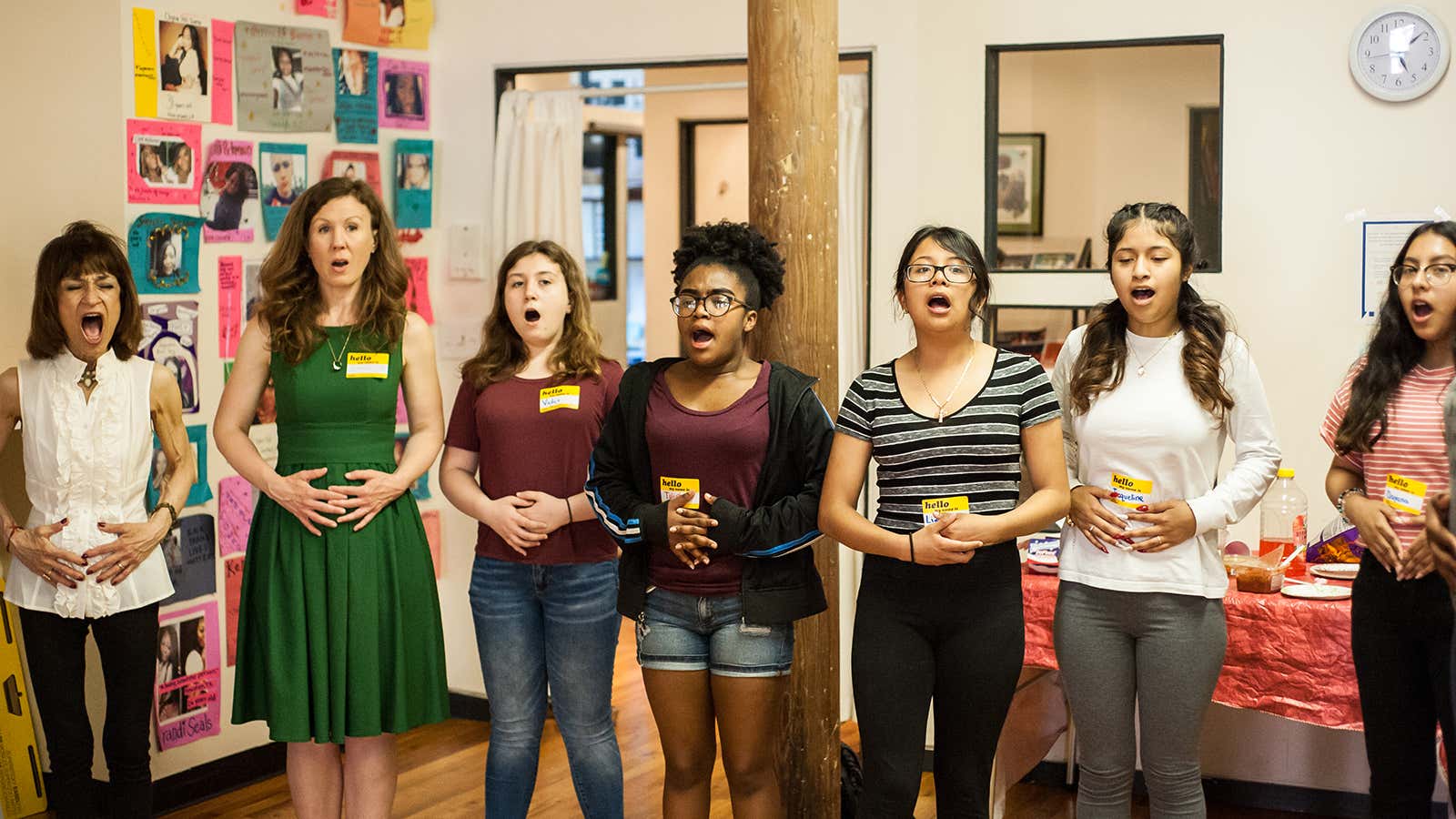In 1970, a New York woman went to a popular army-navy store on the east side of Manhattan called Hudson’s. She picked out a pair of jeans, and tried them on in a storage room since there wasn’t a proper fitting room. As she was changing, a member of staff came into the room, climbed a ladder, and went about rummaging around with his back to her.
“I didn’t like it,” Nadia Telsey, now 71, says. “But I told myself, ‘He’s really not doing anything wrong. He’s just doing his job. And I don’t want to inconvenience his work day.’”
The man got off the ladder and asked about the jeans. Telsey responded that they weren’t right. He took a tape measure from around his neck and put it around her waist.
“So now I’m going, ‘Oh man, I don’t like this at all, but maybe he’s trying to help me get a good pair of jeans that fit right,’” says Telsey. “’And he’s not really doing anything wrong.’”
The man put the tape measure around her thigh, and she made the mental calculation to say nothing, at which point the man undid her pants and went in to measure her bare thigh.
The cloud of ambiguity lifted; this was a violation. “I think you better go now,” she told him. He left immediately.
The anecdotes are ubiquitous, and the details are interchangeable. In just the last week friends and colleagues have told me stories of: a CEO who touched her shoulder, uncomfortably and repeatedly, and each time she was too horrified to tell him to stop; that time she cooked a friendly meal for a longtime acquaintance who was new in town, and after, he whipped out his dick, saying, “It’s just been so long, you know?”; when she sat in the front seat of a taxi because the driver said the backseat was broken, and while they were stuck in tunnel traffic, his hand made his way up her leg.
The run-in at Hudson’s helped Telsey, then in her early twenties, see the need for a self-defense curriculum beyond martial arts. In 1974, she cofounded the Center for Anti-violence Education (CAE) in Brooklyn, which is still open today.
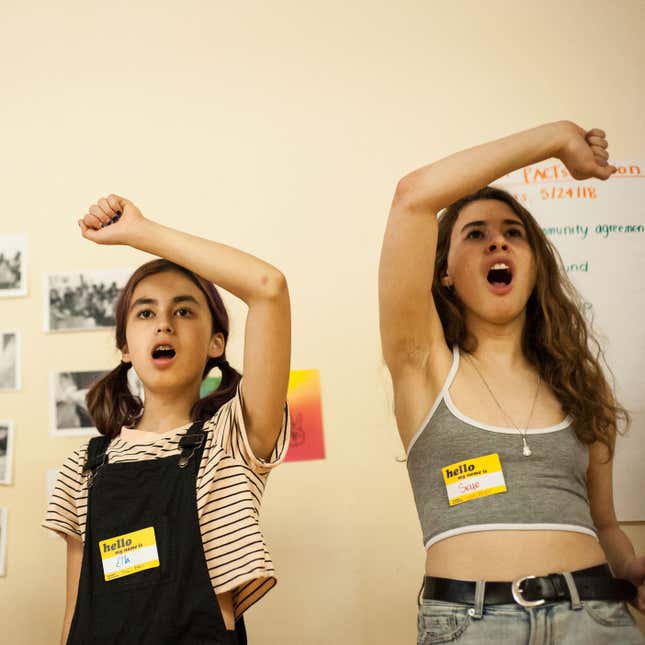
A class might seem like an extreme response to avoiding an awkwardly long conversation with a person in the street. But for 40 years, an “empowerment” approach to women’s self-defense has incorporated physical techniques of groin-slaps and eye-strikes with verbal and emotional training to deescalate seemingly low-stakes boundary crossing—the kind women, young and old, face daily. They teach girls as young as preteens quite literally how to clearly and effectively say “no,” and how to possess their bodies and the space they take up, both physical and emotional.
“Most interpersonal violence starts out as boundary testing; it starts out as small things,” says Susan Schorn, chair of the board of directors for the National Women’s Martial Arts Federation. “Even if it is a stranger attack that ends up being extremely violent, that person is usually going to begin by trying to get close to you physically in a way that doesn’t really feel like an attack.”
At work, in relationships, with their mothers, even with total strangers, women feel pressure to tie themselves in complex knots to avoid simple, truthful denial: “No, that’s not what I want.”
A new syllabus
Empowerment self-defense came out of second-wave feminism. Its founders, mostly white, American women, developed their own curricula as the US was waking up to the fact that rape and sexual assault are most often perpetrated by unarmed people we know: family members, intimate partners, friends, and acquaintances—not masked strangers with guns.
In 2014, Martha Thompson, an instructor based in Chicago, defined four key elements of empowerment self-defense: recognizing that violence is a social issue; holding perpetrators, not victims, responsible; helping women connect to their bodies physically; and teaching tools for self-defense beyond just physical resistance.
The last of these was Telsey’s contribution.
In the late 1980s, after moving west, she wrote a foundational workbook called “Self-defense from the Inside Out.” It taught, among other things, how to assertively say no, and how to overcome the inner voices of self-doubt when we sense we’re in danger.
“We’re taught, ‘Speak up at the first sign of trouble,’” says Telsey. “But the way that assailants work is, the first sign of trouble very often is an ambiguous intrusion on our space: questions that are too personal, a touch that’s not right.”
“We don’t want to accuse them, and we give them the benefit of the doubt, and they take that as a green light,” she says, “So then they go one step more, and one step more, and one step more.”
The movement was simultaneously popping up in other places in the US. Over the following decades, it spread across the country, to Portland, Boston, and Chicago, among others. Today, it’s gaining popularity. “It allows people to approach safety through a social justice lens, [and] it’s much better aligned with growing movements like #MeToo than other systems of self-defense,” says Schorn.
Many young women, say instructors, need convincing that self-defense against sexual assault is relevant to them. But it becomes relevant to a woman the very first time she is caught unprepared.
No thyself
In a recent after-school class at CAE, 12-year-old twins sat in a circle with their two instructors discussing the definition of consent. “Permission?” one student suggested.
“Exactly, right, consent means permission,” said Izzy Finkelstein, a 27-year-old instructor. “If someone wants to touch your body in any way, you have the right to say yes, to say no, or change your mind. Consenting to one thing, like letting someone hold your hand, doesn’t mean you consent to more things.”
“And if you’ve done something before, if you’ve kissed someone in the past, doesn’t mean you’ve consented to doing that forever in the future,” chimed in 20-year-old Bianca Rhea.
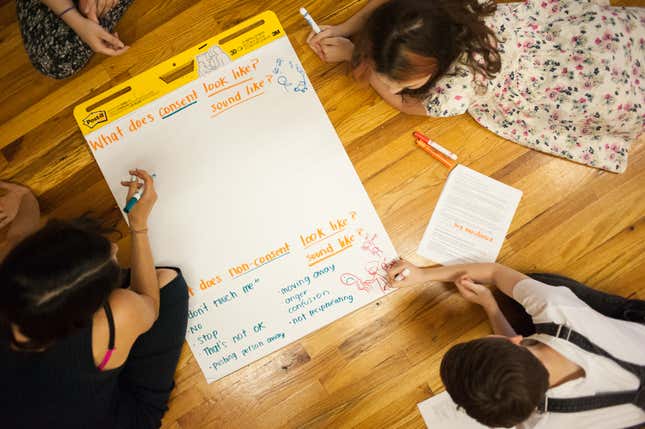
Rhea and Finkelstein role-played being at the movies: Finkelstein put her arm around Rhea, which was welcome, then put a hand on her knee, which was not. Rhea demonstrated her physical non-consent, then verbal. “Could you not touch my leg?” she said.
It didn’t matter that the two preteens had not heard of the Me Too movement; they were getting a very early education in recognizing signs of non-consent.
For college-aged empowerment instruction, the lessons can be more explicit.
“You always have the option to say no,” says Madeleine Lee, a 19-year-old biology major at the University of Oregon, who took an empowerment course for credit at school. She recalls learning the signs of a predator, like “forced teaming,” in which you find yourself in the same sorry situation as another person, and that person forces a bond on you. (“Oh shit, we’ve gotten to the store at the same time as the store closes. What are we going to do now?”) If you feel someone following closely behind you, says Lee, it’s a good idea to look them in the eyes so they know you’re aware of them.
She also remembers a scenario about borrowing pencils. In one exercise, a person persistently asked to borrow a pencil, and students were instructed to say simply, “No, I don’t want to get out my pencil.” A seemingly mundane exercise demonstrated to Lee the extent to which politeness guides her own actions.
“That was just really uncomfortable,” she says, “It kind of sucks … because then you feel bad that you’re not going to allow another person to succeed, and you feel selfish.” And yet, she says, “Females in particular are trained to be very polite. And that’s what a lot of people take advantage of, our niceness and our kindness, to just give and try to make situations easier.”
To withstand potential discomfort, to react in a way that potentially creates friction, and to do so without apologies or defensiveness: In empowerment self-defense, this is key to getting women out of harm’s way.
For Lee, the pivotal lesson was that it’s a woman’s own decision, not somebody’s else’s, what to do with her body, her emotional energy, and her time.
Male instructors, the same ones who get suited up and slapped around, emphasize the point by standing in for the people who would try to dissuade young women, role-playing responses that echo through the annals of Me Too:
“Oh, come on.”
“You seem tense, why don’t we just relax.”
“I didn’t know you were such a feminist.”
“It’s not a big deal.”
“It’s not an argument; it’s not a negotiation; it’s not a philosophical discussion,” says Meg Stone, executive director of IMPACT Boston. “It’s an affirmation of your boundary.”
Assertive is not aggressive
The classes stress the difference between assertiveness and aggressiveness. “I thought that any kind of statement of my needs or my wants was aggressive,” says Lee Paiva, recalling her first empowerment self-defense class. Today she runs No Means No Worldwide, a program that teaches girls as well as boys in Kenya and Malawai with the goal of decreasing rates of rape.
What Paiva calls a “high-quality no” is a short, simple statement: audible, without rising intonation at the end, with emotional control, projecting confidence, non-defensive, non-apologetic, with body language that matches the tone.
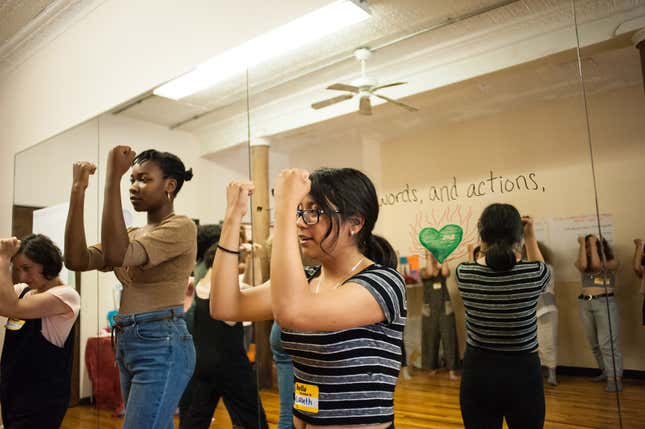
Students practice enduring the awkward silence after the “no,” something that often keeps people talking longer than they want, for the fear of appearing rude. “I was trained to let it stand, let it hang there,” says Paiva, “To not try to rescue anyone from my ‘no.’”
The “high-quality no” is an ideal; the amount of power we have in a situation depends on context, our identities, and the people we’re dealing with. There is no magic answer to whisk away the blinding hot guilt or shame after hearing an obscene remark in the street, no script of perfect zingers. Students are taught that when the times come, they may respond differently, and not to feel ashamed if they freeze up.
But the theory goes that once students have practiced enough sweaty, uncomfortable situations in the classroom, they’re mentally, physically, and emotionally prepared to respond automatically in real life. They’ve become familiar with the feeling of reaching for their voice, and finding it.
Un-blurred lines
Today, the US is reckoning with its rape culture, one which excuses assault by men as normal, and asks women to bear that normalization in the form of jokes, glorified depictions of violence against women, online trolling, and the acts of violence themselves. You may have heard the stats: In 2011, the US Center for Disease Control and Prevention (CDC) found that 19% of US adult women reported having been raped in their lifetimes, with 79% raped before 25. In that same report, the CDC also found that 44% of US adult women had experienced “other forms of sexual violence,” which include “being made to penetrate, sexual coercion, unwanted sexual contact, and noncontact unwanted sexual experiences.”
And despite persistent myths, the overwhelming majority of rapes and sexual assaults in the US are by people we know.
So students are taught how to recognize early on when their personal boundaries are being crossed, and to practice the violation as well as the response: “That’s close enough,” “Can you take a step back?”
At CAE, the youth class students run through a “hug avoidance” exercise: An acquaintance steps forward for an embrace, with arms open, and the student is meant to reach for the outstretched hands and swiftly pull them closed and down between them and the other person, like a gentle human clamp.
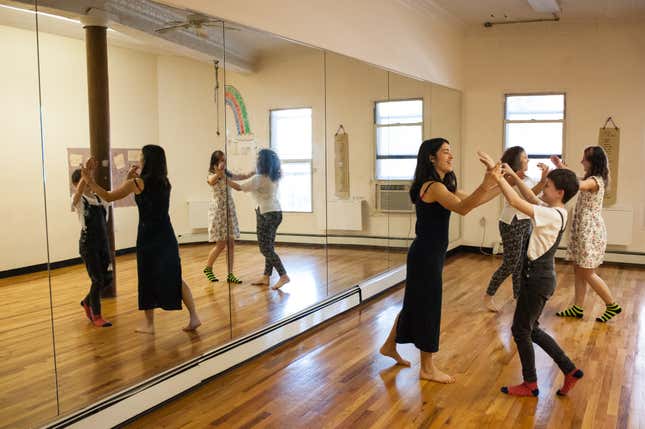
In a second exercise, the students stand still as the instructors stride toward them, and say “stop” when they feel they’ve hit the edge of their comfort zone. In another drill, the instructors ignore the first command, and the student has to get louder and more forceful with their “stop.”
That means learning about emotional boundaries, too. An empowerment class might ask students to bring a scenario about a person with whom they have a boundary issue, but with whom they want to continue to have a relationship.
A simple statement of “I feel _______ when you ________. Please don’t _________.” can be surprisingly difficult in complex relationships. Imagine a roommate who frequently gets drunk and trash talks your other roommate to you; your sister, who calls you to rant for an hour, and then hangs up when she’s done; a coworker you like, who’s overly reliant on your Excel skills. It may be surprisingly difficult to fill those spaces with concrete statements.
That’s what makes practicing these exercises necessary. “You have been acculturated to override that feeling, to make excuses for the other person, and to prioritize the other person’s comfort over your own,” says Lynne Marie Wanamaker, deputy director of Safe Passages in Northampton, Massachusetts.
“Women don’t own ourselves. We don’t own our feelings. We don’t have boundaries,” says Schorn. “What we have is supposed to be constantly available for public use in order to make other people’s lives function better. … To say, ‘Oh no, that’s not my responsibility,’ or ‘I have this private part of me that I do not wish to share with you,’ is seen on some level as taking away something that ought to belong to the public.”
Does it work?
In a study published in 2015 by psychologists from Ontario and Alberta, Canada, just under 900 (mostly white, mostly heterosexual) college women were randomly assigned to either take an education program that incorporates elements of empowerment-self-defense or to receive brochures about sexual assault. One year on, surveys of participants showed that the risk of completed rape was statistically significantly lower in the women who took the course, 5.2% versus 9.8%, compared to the control group. Rates of attempted rape were also statistically lower, 3.4% compared to 9.3%.
Two years on, a follow-up analysis of a subset of the participants from the same experiment showed the reduction in attempted rape was still significant.
“Because women cannot control men’s perpetration behavior, the reductions in the risks of attempted rape and coercion and unwanted sexual contact suggest that the resistance program may have increased women’s ability to detect and interrupt men’s behavior at an early stage,” write the researchers.
There are feminist critics who believe that any women’s self-defense is a form of victim blaming. And there are also critics who believe that the empowerment approach, with its heavy emphasis on holding the assailant responsible, is not enough, because it implies that the person being attacked is helpless.
Marc MacYoung has been teaching self-defense since 1989 and is most recently the author of What You Don’t Know Can Kill You. “Now, you can’t blame the victim: I find this to be utterly and totally disempowering,” he says. “It’s having the opposite effect. Because you really do have a lot of influence in what happens to you, and in a two-person situation, you are half that equation.”
The future is forthright
Lauren R. Taylor, who has been working against gender-based violence for 40 years, took her first self-defense class in 1985. She says that the main shift she’s seen over the decades is that after title IX, which gave American girls ready access to school sports programs, girl students are more comfortable with finding power in their bodies. “But in terms of, ‘Can I speak up on my own behalf?’ Millennials have just as hard a time as people my age,” she says. “That hasn’t changed.”
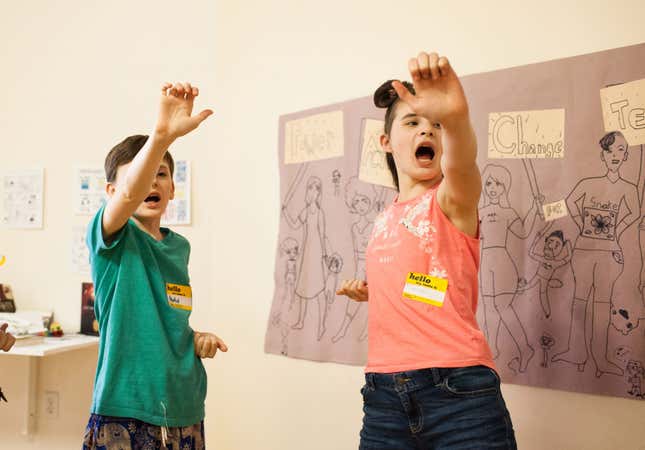
Some critics argue that emphasizing women’s self-defense distracts from the real problem: toxic masculinity and the way men feel entitled to women, mentally and physically. But Taylor and others who teach the program say that today’s young women need tools to protect themselves while society works to bring about deeper cultural change.
“I completely agree that men are responsible, [but] how many generations is that going to take? Are we supposed to just sit there and take it for all those generations?” says Taylor. “Just experience the abusive relationships, the sexual assault, the street harassment, the trafficking, the stalking, in that time? Really, what’s the problem with knowing how to say, ‘That’s not OK with me?’”
